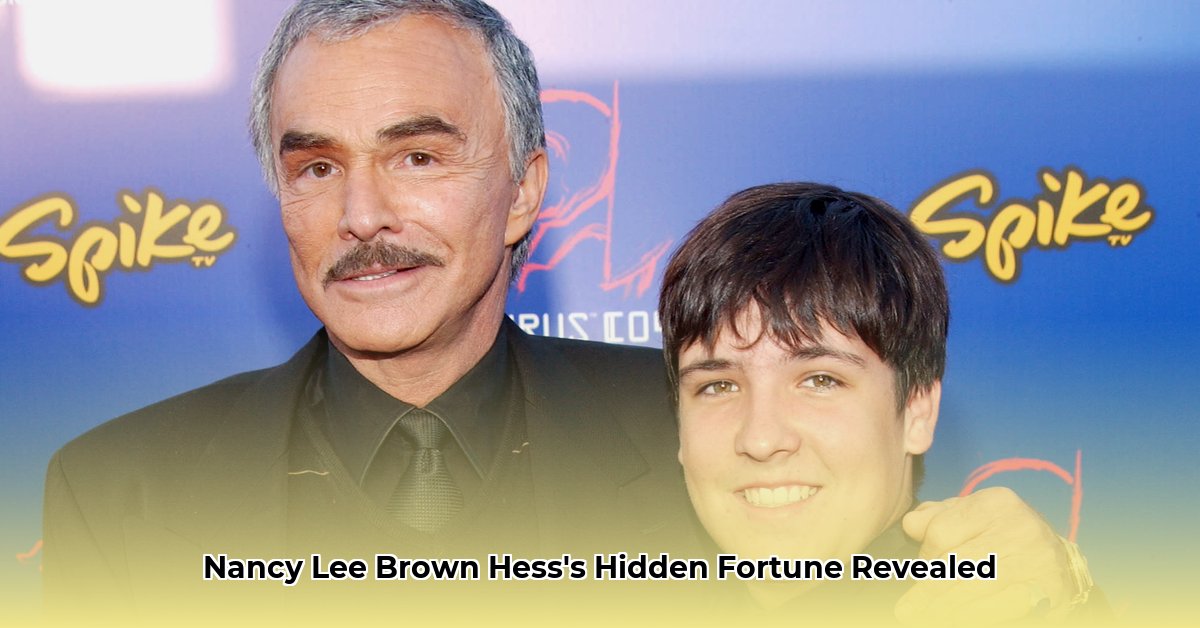
Nancy Lee Brown Hess: Navigating the Complexities of Burt Reynolds' Estate
The death of Hollywood icon Burt Reynolds left behind not only a legacy of iconic roles but also a complex estate, the management of which offers a compelling case study in celebrity estate planning. While the precise net worth of Nancy Lee Brown Hess, Reynolds' niece and executor of his will, remains undisclosed, her role provides crucial insights into the intricate world of handling a substantial celebrity fortune. This isn't merely a story about money; it's a narrative about family, strategic planning, and the often-turbulent waters of inheritance. How did Hess navigate this complex situation, and what lessons can we learn from the Reynolds estate?
The Executor's Crucial Role: Beyond Number Crunching
Nancy Lee Brown Hess's appointment as executor wasn't a simple matter of selecting a family member. Given the pre-existing trust established for Burt's son, Quinton Reynolds, a neutral party was essential to avoid potential family conflicts so common in high-profile estates. Hess's position acted as a crucial buffer, maintaining objectivity and mitigating potential disputes. Her responsibilities extended far beyond basic accounting; she navigated complex legal documents, addressed intricate tax implications, and managed the intense media scrutiny that inevitably accompanies such cases. This highlights the high-pressure nature of the role and the need for considerable skill and experience. Did the existence of a pre-existing trust effectively mitigate potential family drama? The answer, in part, lies in examining the trust's structure itself.
The Power of Pre-Existing Trusts: Securing Quinton's Future
The pre-existing trust for Quinton Reynolds is a pivotal element of the estate's strategy. This wasn't a hasty, last-minute decision; rather, it demonstrates sophisticated, long-term financial planning. This trust served as a protective shield, safeguarding Quinton's inheritance from immediate public scrutiny and preventing the potential for hasty spending or legal battles. It ensured his long-term financial security, providing a dependable stream of support regardless of unforeseen circumstances. By channeling the inheritance through a trust, Burt Reynolds likely aimed to minimize estate taxes and ensure his son's financial well-being, avoiding the potential pitfalls of receiving a large sum of money suddenly. What specific legal structures were employed? This remains largely unknown to the public.
Celebrity Estate Planning: A Behind-the-Curtain Look
The Reynolds estate plan underscores the critical elements of financial planning for high-net-worth individuals, particularly those in the public eye. The use of a pre-existing trust is a common and effective strategy, offering tax efficiencies and responsible long-term asset management. The overarching goal is to ensure the beneficiary receives funds responsibly, fostering financial prudence. It’s about far more than just wealth preservation; it's about safeguarding a legacy. The selection of an experienced executor like Hess was also pivotal, her expertise ensuring legal compliance, smooth estate administration, and adherence to Burt's wishes. What other strategies could have been employed to further safeguard the estate's assets?
Legal and Tax Complexities: Navigating a Regulatory Maze
Managing a large estate, especially a celebrity's, involves navigating a complex web of legal and tax regulations. Inheritance laws, tax implications, and potential legal challenges are considerable hurdles. Reynolds's estate planning showcases how careful planning can strategically mitigate these risks. The use of a trust and the choice of a neutral executor demonstrably reduced the likelihood of disputes and costly legal battles. The plan itself underscores the importance of expert legal counsel in managing such intricate estate matters. What specific legal and tax challenges are inherent in celebrity estate planning?
Family Dynamics and the Estate: A Delicate Balance
While specific details of the Reynolds family dynamics remain private, the estate plan itself suggests a careful consideration of family relationships. The trust for Quinton, while excluding direct inheritance through the will, likely reflects a conscious effort to mitigate potential family tensions. Hess's selection as an independent executor reinforces this, prioritizing smooth administration and conflict resolution. Given Burt's documented complex financial history, this suggests an intention to minimize potential post-mortem disputes and public controversy. What role did open communication play in the successful management of Reynolds' estate?
Lessons Learned: Preparing for the Unforeseen
The Burt Reynolds estate serves as a powerful case study in effective estate planning. Thorough preparation, including establishing trusts, choosing a capable executor, and addressing family dynamics, is crucial. Proactive strategies can significantly reduce the likelihood of disputes and ensure the inheritance serves the best interests of all involved. Effective estate planning is not simply about managing assets; it's about safeguarding a person's wishes and the well-being of their loved ones. It necessitates careful thought, proactive planning, and expert guidance. What are the most common pitfalls to avoid in estate planning?